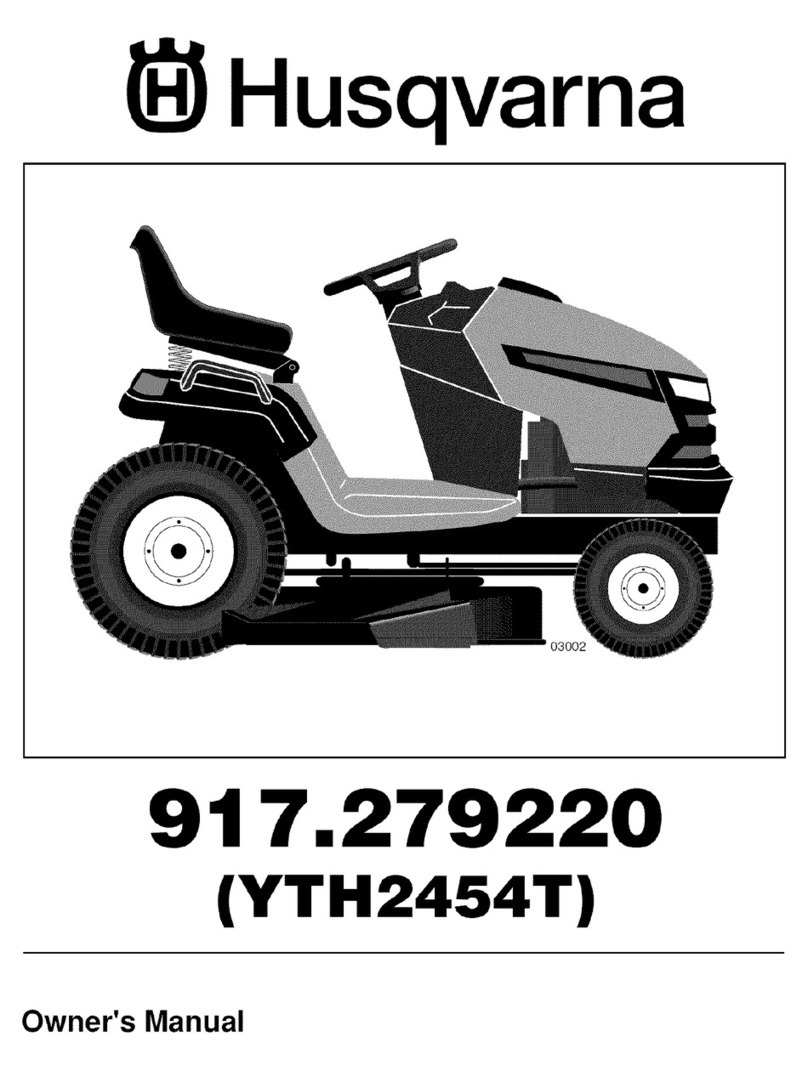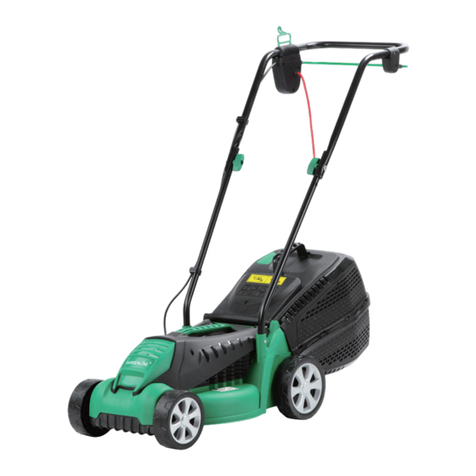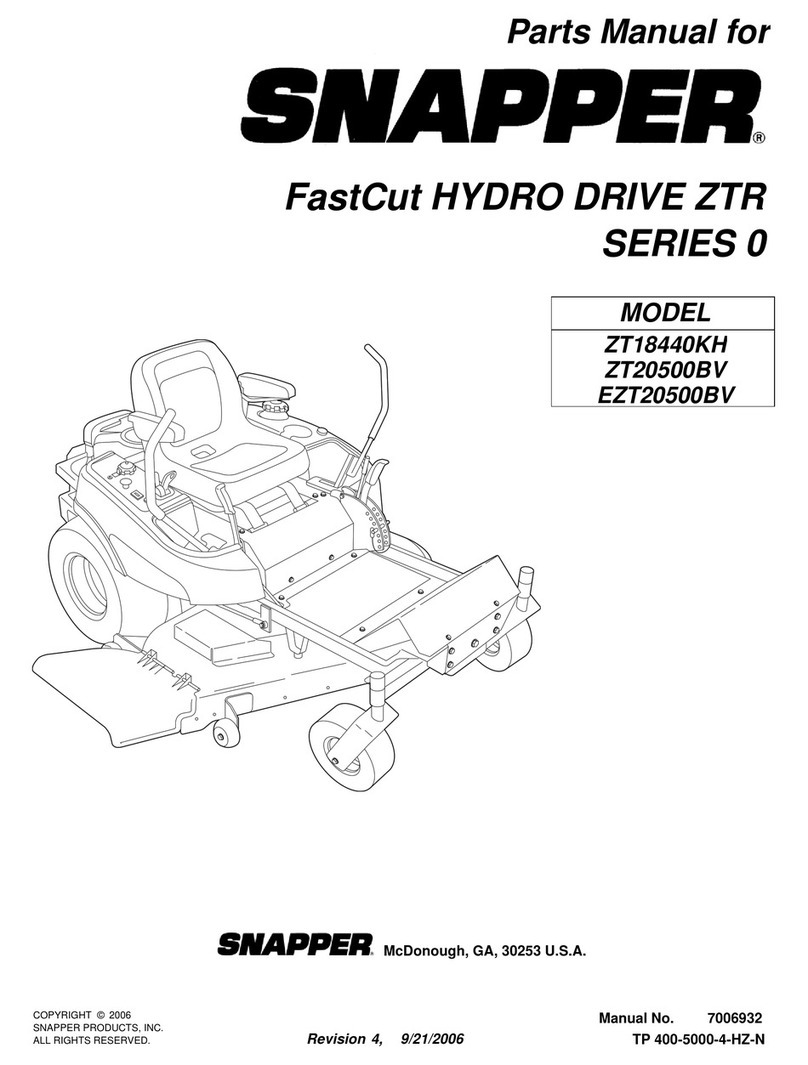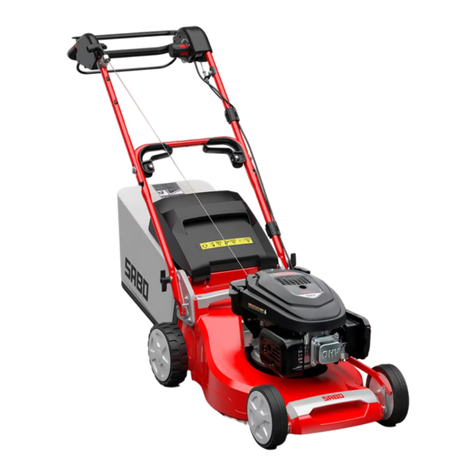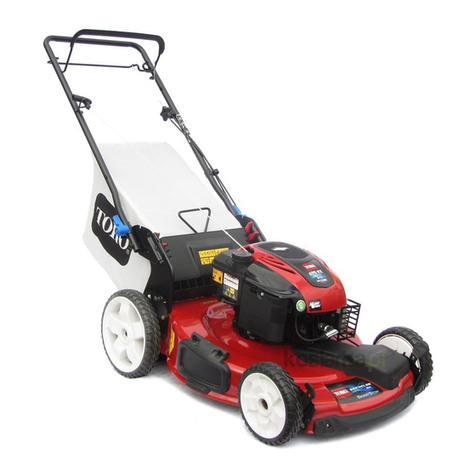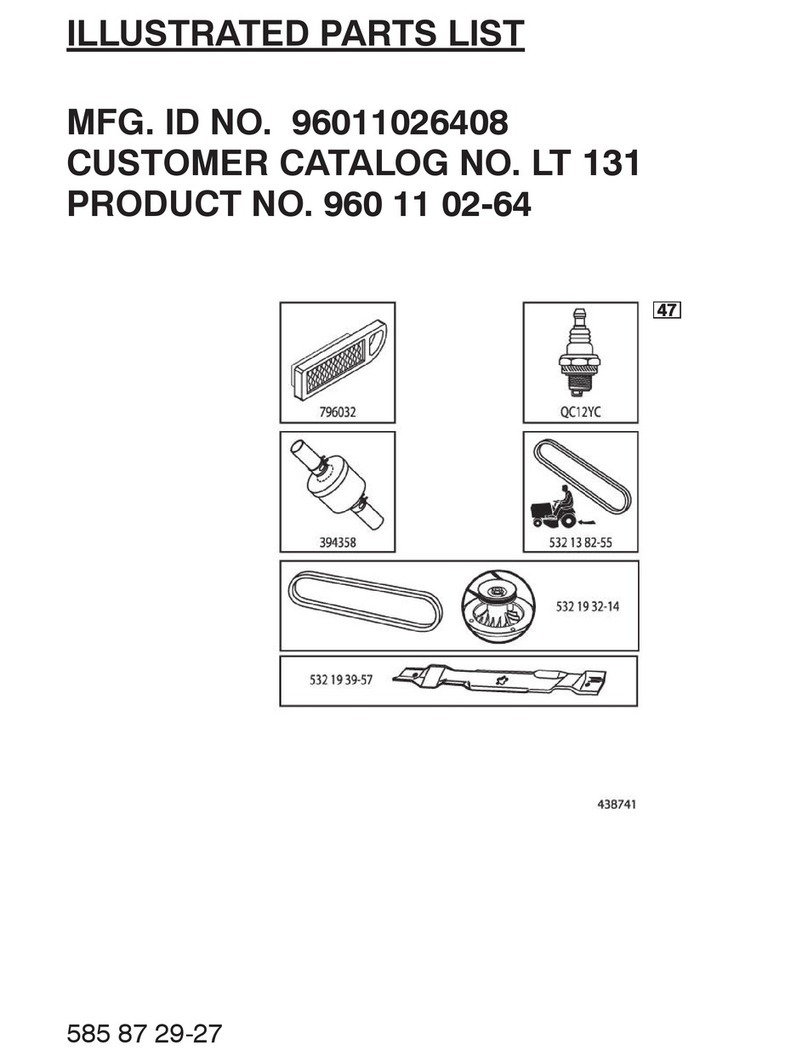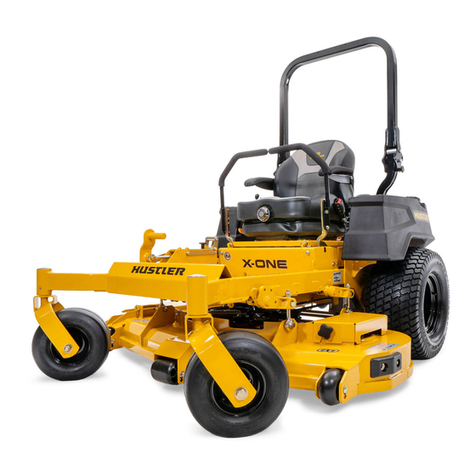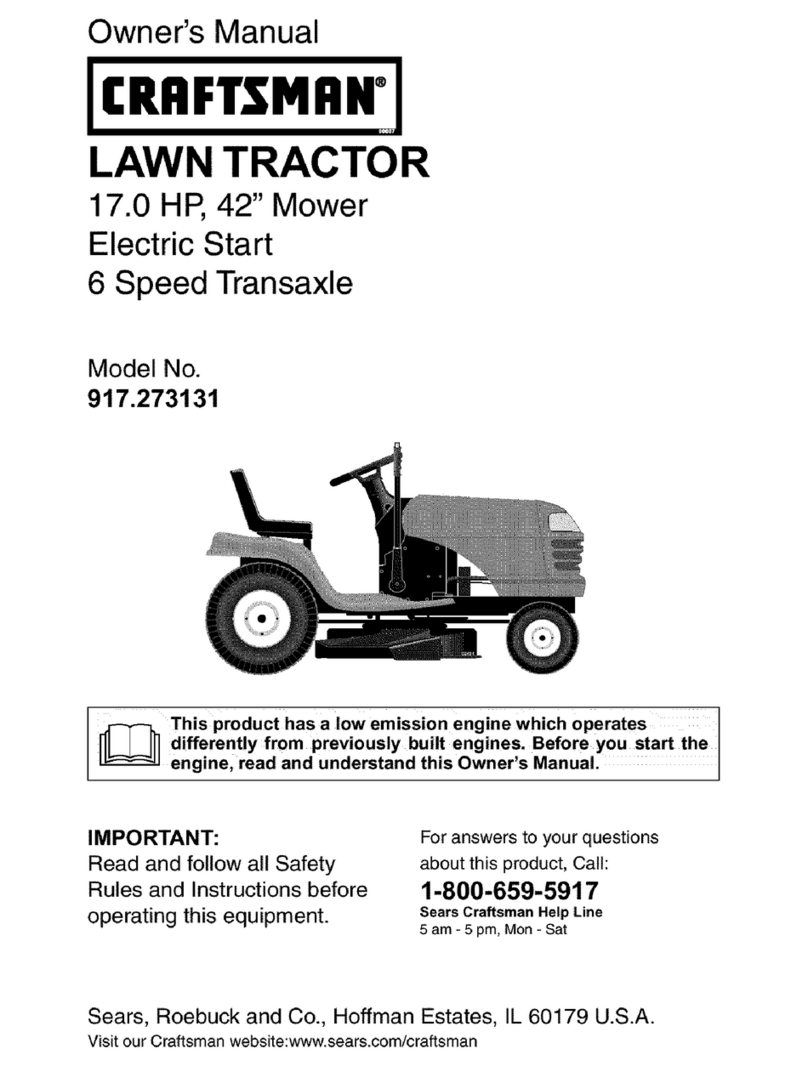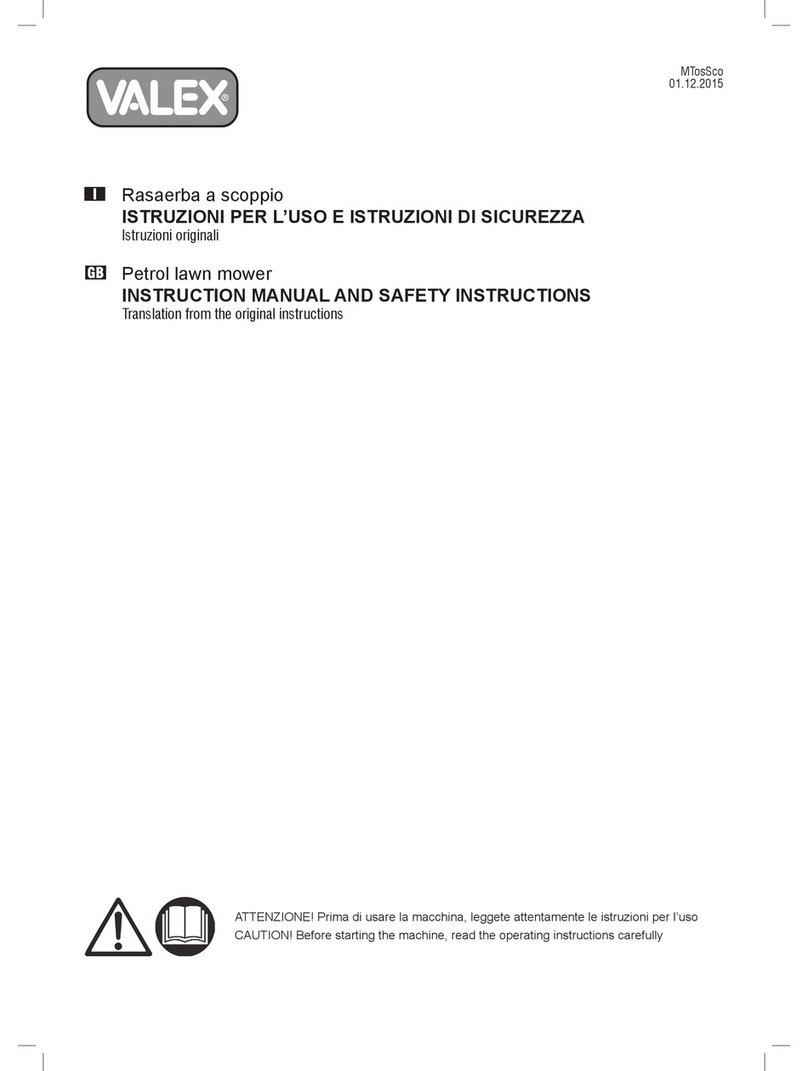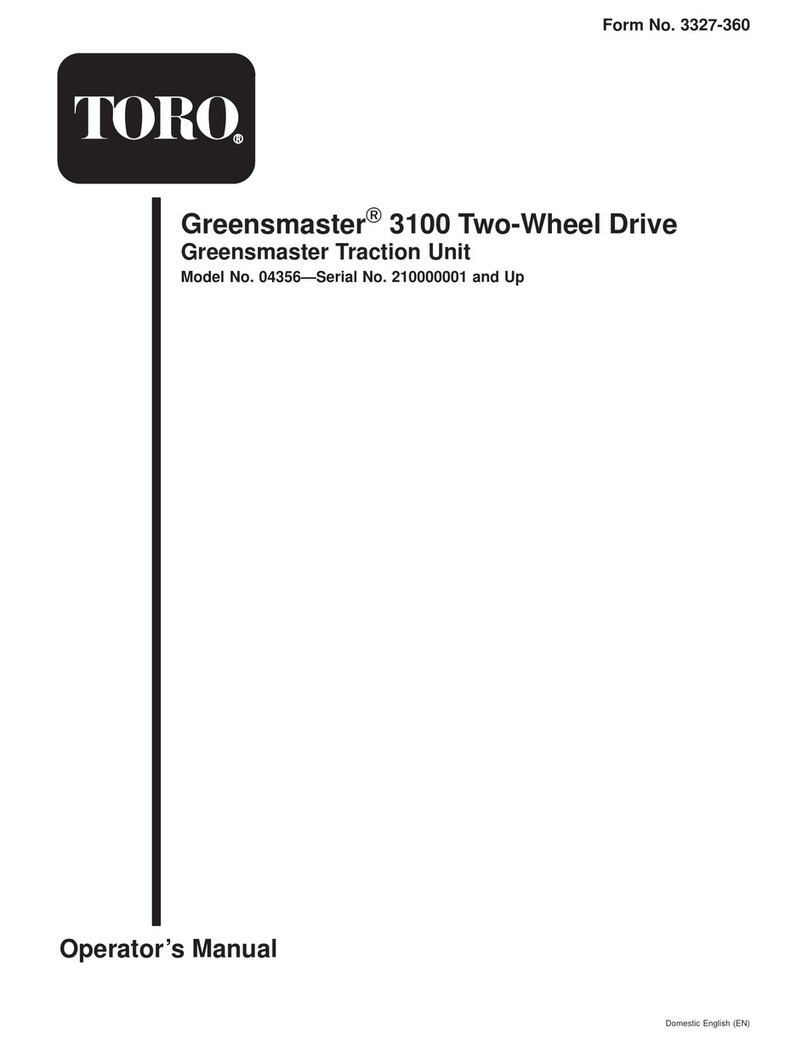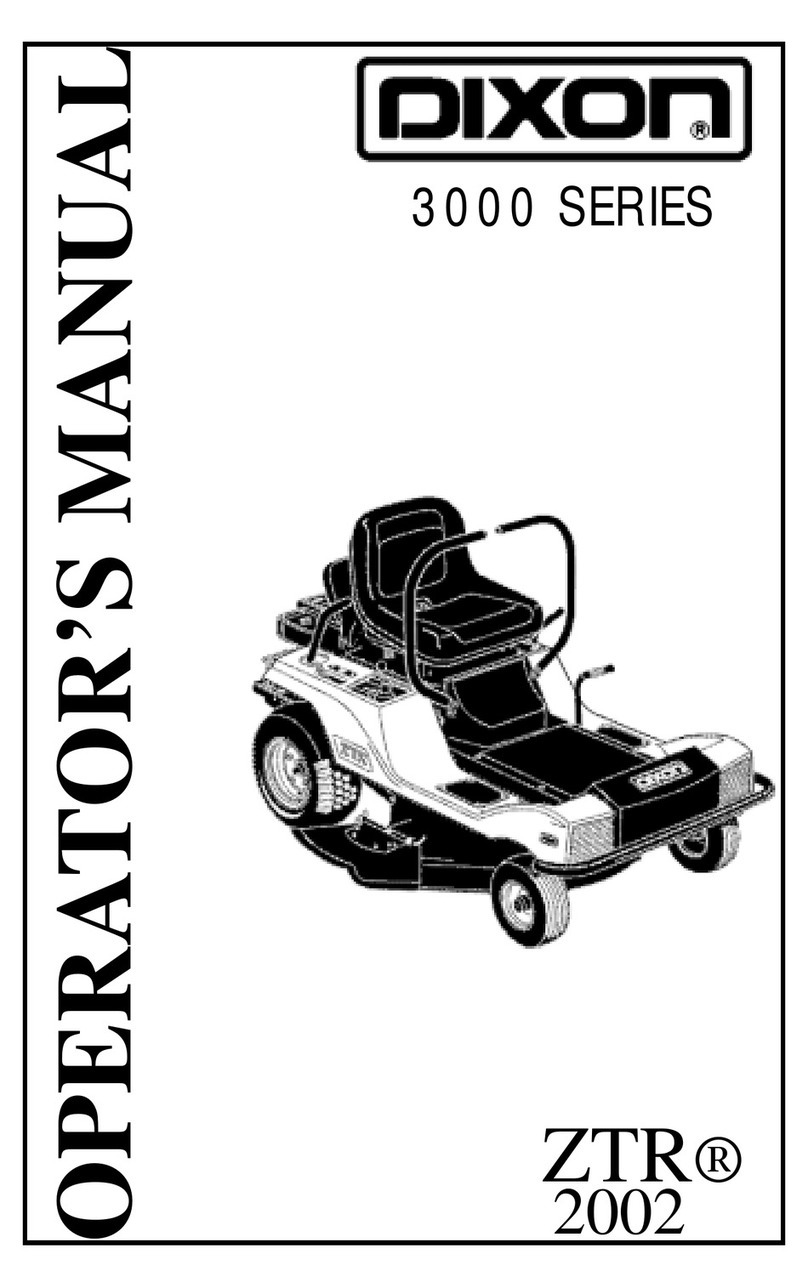Derby The Morgan User manual

TM
1822347
Rev. 10/2000
TP 100-7008-00-MG-D
The Morgan
Three-Wheel Riding Mower
Tractor Model:
TW20
Mower Model:
TW61
mowers are built by
Ferris Industries, a
Simplicity company.
Ferris Industries
5375 North Main Street
Munnsville, NY 13409
800-933-6175
TM
OPERATOR’S
MANUAL

Ferris Industries
5375 North Main Street
Munnsville, NY 13409
800-933-6175
www.ferrisindustries.com
© Copyright 2000 Ferris Industries
All Rights Reserved. Printed in USA.
FERRIS
DERBY LIMITED WARRANTY
IMPORTANT
This warranty shall apply ONLY if the warranty registration form has been completed and
returned to Ferris Industries, Inc. within 20 days from the date of delivery.
Ferris Industries, Inc. (Ferris) warrants, in accordance with the provisions below, to the
original purchaser for the period of twenty-four (24) months, twelve (12) months for com-
mercial use, from the date of delivery of a Derby mower that the mower is free from
defects in material or workmanship. Derby’s obligation under this warranty is to repair or
replace, at Derby’s election, without charge and at the place of business of a dealer
authorized to handle Derby mowers, any part or parts of the machine which, in the judg-
ment of Derby, prove to be defective.
THIS WARRANTY AND DERBY’S OBLIGATION HEREUNDER IS IN LIEU OF ALL
OTHER WARRANTIES, EXPRESSED OR IMPLIED, INCLUDING, WITHOUT LIMITATION,
THE IMPLIED WARRANTY OF MERCHANTABILITY OR IMPLIED WARRANTY OF FIT-
NESS FOR PARTICULAR PURPOSE, and all other obligations or liabilities of Derby for
incidental and consequential damages resulting from the design, manufacture, sale or use
of the machine. No person is authorized to make any warranty or assume for Derby any
liability not strictly in accordance with this warranty.
This warranty shall not apply to any mower part which, in the judgment of Derby, has been
altered or tampered with in any way or has been subjected to misuse, neglect or accident,
or has had the serial numbers altered, effaced or removed. This warranty does not apply
to component parts not manufactured by Derby (motors, tires, belts) except to the extent
of their individual manufacturer’s guarantees.
Ferris Industries, Inc. is continually striving to improve its products, and therefore reserves
the right to make improvements or change when it becomes practical and possible to do
so, without incurring any obligation to make changes or additions to the equipment sold
previously.

1
WARNING
Engine exhaust from this product contains
chemicals known, in certain quantities, to cause
cancer, birth defects, or other reproductive harm.
Table of Contents
Identification Numbers .......................................2
Safety Rules & Information ................................3
Features & Controls............................................6
Control Functions....................................................6
Safety Interlock System ..........................................7
Operating the Morgan.........................................8
General Operating Safety .......................................8
Checks Before Starting ...........................................8
Starting the Engine .................................................9
Stopping the Tractor and Engine.............................9
Mowing....................................................................9
Pushing the Rider by Hand.....................................9
Three Wheel Mower Driving Practice ...................10
Storage..................................................................11
Starting After Long Term Storage .........................11
Regular Maintenance ........................................12
Maintenance Schedule .........................................12
Checking Tire Pressures.......................................12
Checking/Adding Fuel...........................................13
Fuel Filter ..............................................................13
Oil & Filter Change ...............................................13
Check/Change Air Filter........................................13
Replace Spark Plug ..............................................13
Check Hydraulic Oil Level .....................................13
Lubrication ............................................................14
Battery Maintenance.............................................14
Checking Battery Fluid ....................................14
Cleaning the Battery and Cables ....................14
Servicing the Mower Blades .................................15
Troubleshooting, Adjustments & Service .......17
Troubleshooting the Tractor...................................17
Troubleshooting the Mower...................................18
Mowing Height Adjustment ...................................19
Service Brake Adjustment ....................................19
Parking Brake Adjustment ....................................19
Transmission Foot Control
Pedal Neutral Adjustment................................19
Belt Removal & Replacement ...............................20
Mower Deck Drive Belt....................................20
Blade Spindle Drive Belt..................................20
Transmission Drive Belt ...................................20
Belt Tension & Adjustment ....................................21
Mower Deck Drive Belt....................................21
Blade Spindle Drive Belt..................................21
Transmission Drive Belt ...................................21
PTO Clutch Adjustment ........................................22
Blade Brake Check ...............................................22
Battery Service .....................................................23
Checking the Battery Voltage............................23
Charging A Completely
Discharged Battery .......................................23
Jump Starting with
Auxiliary (Booster) Battery ............................23
Lawn Care & Mowing Information ...............LC-1
International Symbols...................................LC-8
Technical Manuals.........................................LC-8
NOTE: In this manual, “left”and “right”are referred to as
seen from the operating position.
© Copyright 2000 Ferris Industries
All Rights Reserved. Printed in USA.
TP 100-7008-00-MG-D

2
IDENTIFICATION TAG LOCATIONS
Identification
Numbers
When contacting your
Authorized Dealer for
replacement parts, service,
or information YOU MUST
HAVE THESE NUMBERS.
IDENTIFICATION NUMBERS
Record your model name/number, unit and mower deck
manufacturer numbers and engine serial number in the
space provided for easy reference.
•The Tractor I.D. tag is located on the front of the
trailer column, below the control panel.
•The Mower Deck I.D. tag is located on the right-
hand side of the mower deck, under the deck guard.
•For location of Engine Serial Number, refer to the
Engine Owner’s Manual.
Be sure to fill out and return the Warranty Registration
Card supplied with your unit.
ENGINE REFERENCE DATA
Model Description Name
Unit MODEL Number
PRODUCT REFERENCE DATA
Unit SERIAL Number
Dealer Name Date Purchased
Engine Make/Model Engine ID/Serial Number
Mower Deck MODEL Number Mower Deck SERIAL Number
Tractor
identification tag
MODEL NO. SERIAL NO.
FERRIS INDUSTRIES, INC.
MUNNSVILLE, NY 13409
MADE IN THE USA
FERRIS
XXXXXXX XXXXXXX
Mower Deck
identification tag

3
Read these safety rules and follow them closely. Failure to obey these rules could result in loss of con-
trol of unit, severe personal injury or death to you, or bystanders, or damage to property or equipment.
This mowing deck is capable of amputating hands and feet and throwing objects. The triangle
in text signifies important cautions or warnings which must be followed.
Safety Rules
& Information
WARNING
Never operate on slopes greater than 30 percent
(16.7°), which is a rise of three feet vertically in 10
feet horizontally.
Use extra caution when operating on slopes with rear-
mounted grass catcher.
Mow UP and DOWN the slope, never across the
face, use caution when changing directions and
DO NOT START OR STOP ON SLOPE.
GENERAL OPERATION
•Read, understand, and follow all instructions in the
manual and on the unit before starting.
•Only allow responsible adults, who are familiar with
the instructions, to operate the unit.
•Clear the area of objects such as rocks, toys, wire,
etc., which could be picked up and thrown by the
blade(s).
•Be sure the area is clear of other people before
mowing. Stop unit if anyone enters the area.
•Never carry passengers.
•Do not mow in reverse unless absolutely necessary.
Always look down and behind before and while trav-
elling in reverse.
•Be aware of the mower discharge direction and do
not point it at anyone. Do not operate the mower
without either the entire grass catcher or the deflec-
tor in place.
•Slow down before turning.
•Never leave a running unit unattended. Always
disengage the PTO, set parking brake, stop engine,
and remove keys before dismounting.
•Turn off the PTO switch to disengage the blades
when not mowing.
•Stop engine before removing grass catcher or
removing debris from chute.
•Mow only in daylight or good artificial light.
•Do not operate the unit while under the influence of
alcohol or drugs.
•Watch for traffic when operating near or crossing
roadways.
•Use extra care when loading or unloading the unit
into a trailer or truck.
•Data indicates that operators, age 60 years and
above, are involved in a large percentage of riding
mower-related injuries. These operators should eval-
uate their ability to operate the riding mower safely
enough to protect themselves and others from seri-
ous injury.
SLOPE OPERATION
Slopes are a major factor related to loss-of-control and
tip-over accidents, which can result in severe injury or
death. All slopes require extra caution. If you cannot
back up the slope or if you feel uneasy on it, do not
drive on it.
Do
•See your authorized dealer for recommendations of
available weights to improve stability.
•Mow up and down slopes, not across.
•Remove obstacles such as rocks, tree limbs, etc.
•Watch for holes, ruts, or bumps. Uneven terrain could
overturn the unit. Tall grass can hide obstacles.
•Use slow speed. Choose a slow speed so that you
will not have to stop or change speed while on the
slope.
•Use extra care with grass catchers or other attach-
ments. These can change the stability of the unit.
•Keep all movement on the slopes slow and gradual.
Do not make sudden changes in speed or direction.
Do Not
•
Do not
start or stop on a slope. If tires lose traction,
disengage the blade(s) and proceed slowly straight
down the slope.
•
Do not
turn on slopes unless necessary, and then,
turn slowly and gradually downhill, if possible.
•
Do not
mow near drop-offs, ditches, or embank-
ments. The mower could suddenly turn over if a
wheel is over the edge of a cliff or ditch, or if an edge
caves in.
•
Do not
mow on wet grass. Reduced traction could
cause sliding.
•
Do not
try to stabilize the unit by putting your foot on
the ground.
•
Do not
use grass catcher on steep slopes.

4
Safety Rules & Information
CHILDREN
Tragic accidents can occur if the operator is not alert to
the presence of children. Children are often attracted to
the unit and the mowing activity. Never assume that chil-
dren will remain where you last saw them.
•Keep children out of the mowing area and under the
watchful care of another responsible adult.
•Be alert and turn unit off if children enter the area.
•Before and during reverse operation, look behind and
down for small children.
•Never carry children. They may fall off and be seri-
ously injured or interfere with safe unit operation.
•Never allow children to operate the unit.
•
Use extra care when approaching blind corners, shrubs,
trees, or other objects that may obscure vision.
TRANSPORTING AND STORAGE
•Always observe safe refueling and fuel handling
practices when refueling the unit after transportation
or storage.
•Always follow the engine manual instructions for
storage preparations before storing the unit for both
short and long term periods.
•Always follow the engine manual instructions for
proper start-up procedures when returning the unit to
service.
•Never store the unit or fuel container inside where
there is an open flame or pilot light, such as in a
water heater. Allow unit to cool before storing.
SERVICE AND MAINTENANCE
•Use extra care when handling gasoline and other
fuels. They are flammable and vapors are explosive.
a) Use only an approved container.
b) Never remove fuel cap or add fuel with the engine
running. Allow engine to cool before refueling. Do
not smoke.
c) Never refuel the unit indoors.
•Never run a unit in an enclosed area.
•Keep nuts and bolts, especially blade attachment
bolts, tight and keep equipment in good condition.
•Never tamper with safety devices. Check their proper
operation regularly.
•Keep unit free of grass, leaves, or other debris build-
up. Clean up oil or fuel spillage.
•Stop and inspect the equipment if you strike an
object. Repair, if necessary, before restarting.
•Never make adjustments or repairs with the engine
running unless specified otherwise in the engine
manufacturer’s manual.
•Grass catcher components are subject to wear, dam-
age, and deterioration, which could expose moving
parts or allow objects to be thrown. Frequently check
components and replace with manufacturer’s recom-
mended parts, when necessary.
•Mower blades are sharp and can cut. Wrap the
blade(s) or wear gloves, and use extra caution when
servicing them.
•Check brake operation frequently. Adjust and service
as required.
•Use only factory authorized replacement parts when
making repairs.
•Always comply with factory specifications on all
settings and adjustments.
•Only authorized service locations should be utilized
for major service and repair requirements.
•Never attempt to make major repairs on this unit
unless you have been properly trained. Improper
service procedures can result in hazardous opera-
tion, equipment damage and voiding of manufactur-
er’s warranty.

5
SAFETY DECALS
This unit has been designed and manufactured to pro-
vide you with the safety and reliability you would expect
from a leader in the outdoor power equipment industry.
Although reading this manual and the safety instructions
it contains will provide you with the necessary basic
knowledge to operate this equipment safely and effec-
tively, we have placed several safety labels on the unit to
remind you of this important information while you are
operating your unit.
All DANGER, WARNING, CAUTION and instructional
messages on your rider and mower should be carefully
read and obeyed. Personal bodily injury can result when
these instructions are not followed. The information is for
your safety and it is important! The safety decals below
are on your rider and mower.
If any of these decals are lost or damaged, replace them
at once. See your local dealer for replacements.
These labels are easily applied and will act as a con-
stant visual reminder to you, and others who may use
the equipment, to follow the safety instructions neces-
sary for safe, effective operation.
DANGER
ROTATING CUTTING BLADE
Do not put hands or feet
under mower deck while
blade is rotating.
1704276
DANGER
ROTATING CUTTING BLADE
Do not operate mower
without deflector or entire
grass catcher in place. 1704277
Safety Rules & Information
Decal - Danger
Part No. 1704276 Decal - Danger
Part No. 1704277
Decal - Warning/Danger
Part No. 45555 Decal - Operation & Controls
Part No. 45558

6
Features & Controls
of the Morgan 3-Wheel Rider
CONTROL FUNCTIONS
The information below briefly describes the function of individual controls. Starting, stopping, driving, and mowing
require the combined use of several controls applied in specific sequences. To learn what combination and sequence
of controls to use for various tasks see the Operating the Morgan section.
A. Transmission Foot Control Pedal
This pedal controls the ground speed of the rider.
Depressing the pedal forward increases the FORWARD
speed of the rider, and depressing rearward on on the
pedal increases the REVERSE speed.
Note: The further the pedal is moved away from the neu-
tral position the faster the drive wheel will turn.
B. Parking Brake Lever
The parking brake lever is engaged by pulling the lever
towards the operator. The notch on the link fastened to
the engine deck will lock the transmission in neutral.
To release the parking brake, slowly push the lever for-
ward until it reaches the end if its travel. Allowing the
lever to "snap" into the OFF position will place undue
strain on the lever and brake linkages.
Please take a moment and familiarize
yourself with the name, location, and
function of these controls so that you
will better understand the safety and
operating instructions provided in this
manual.
M
IK
J
L
C
A
E
D
B
F
H
G
C. Service Brake
The service brake is located to the right of the transmis-
sion foot control pedal and can be used to stop the rota-
tion of the drive wheels.
D. Ignition Switch
The ignition switch starts and stops the engine, it has
three positions:
OFF Stops the engine and shuts off the
electrical system.
RUN Allows the engine to run and powers the
electrical system.
START Cranks the engine for starting.
NOTE: Never leave the ignition switch in the RUN posi-
tion with the engine stopped–this drains the battery.
Figure 1. Control Locations

7
Features & Controls
SAFETY
INTERLOCK SYSTEM
This unit is equipped with safety interlock switches and
other safety devices. These safety systems are present
for your safety, do not attempt to bypass safety switch-
es, and never tamper with safety devices. Check their
operation regularly.
Operational SAFETY Checks
Your unit is equipped with a foot-operated switch safety
system. Check the switch operation every fall and spring
with the following tests.
Test 1 — Engine should NOT crank if:
•PTO switch is engaged, OR
•Parking brake is not engaged, OR
•Operator presence plate is not depressed.
Test 2 — Engine SHOULD crank if:
•PTO switch is NOT engaged, AND
•Parking brake is engaged, AND
•Operator presence plate is depressed.
Test 3 — Engine should SHUT OFF if:
•Operator presence plate is released with PTO
engaged, OR
•Operator presence plate is released with parking
brake disengaged.
NOTE: Once the engine has stopped, PTO switch must
be turned off, parking brake must be engaged.
Test 4 — Blade Deck Lift Interlock
Mower blades will shut off if the mower deck is raised
while the PTO is engaged. To continue mowing, the
PTO switch must be disengaged and the deck must be
lowered completely (the actuator wil make a “ratcheting”
sound) before the PTO can be re-engaged.
Test 5 — Blade Brake Check
Mower blades and mower drive belt should come to a
complete stop within five seconds after electric PTO
switch is turned off (or operator presence plate is
released). If mower drive belt does not stop within five
seconds, see PTO CLUTCH ADJUSTMENT section.
WARNING
If the unit does not pass a safety test, do not
operate it. See your authorized dealer. Under no
circumstance should you attempt to defeat the
purpose of the safety interlock system.
E. PTO (Power Take Off) Switch
The PTO switch engages and disengages the mower.
Pull UP on the switch to engage, and push DOWN to
disengage.
F & G. Throttle / Choke Control
Pulling the round choke control knob (I) out fully chokes
the engine for cold starts. (A warm engine may not
require choking.) Moving the throttle control (H) fully for-
ward is FULL throttle position. Always operate the unit
at FULL throttle when mowing.
H. Deck Lift Actuator Switch
The deck lift actuator switch raises and lowers the
engine and mower decks for ease of serviceability.
Pulling back on the switch will raise the deck, and push-
ing forward will lower the deck. The actuator must be
fully extended during mowing operation. A “ratcheting”
sound will be heard at the end on the actuator’s stoke in
both directions.
I. Hour Meter
Measures the time of the PTO being engaged.
J. Operator Presence Foot Pedal
This pedal is part of the electrical safety system. It must
be depressed by the operator’s left foot in order to start
the engine. It must remain depressed to release the
parking brake and engage the PTO switch.
K. Steering Handle
This handle controls the steering of the machine. Turn
the handle in the desired direction will turn the machine.
The farther the handle is turned, the tighter the turn will
be.
L. Fuel Shut Off Valve
The fuel shut-off valve is located at the bottom of the
fuel tank. The fuel valve is OPEN if the shut-off lever is
VERTICAL. The fuel valve is CLOSED when the shut-off
lever is HORIZONTAL.
M. Seat Adjustment Lever
The seat can be adjusted forward and back. Move the
lever forward, position the seat as desired, and release
the lever to lock the seat in position.

8
Operating the Morgan
Three Wheel Rider
GENERAL OPERATING SAFETY
Before first time operation:
•Be sure to read all information in the Safety and
Operation sections before attempting to operate this
tractor and mower.
•Become familiar with all of the controls and how to
stop the unit.
•Drive in an open area without mowing to become
accustomed to the unit brake pedal or set the park-
ing brake.
CHECKS BEFORE STARTING
•Check that crankcase is filled to full mark on dipstick.
See the engine Operator’s Manual for instructions
and oil recommendations.
•Make sure all nuts, bolts, screws and pins are in
place and tight.
•Adjust the seat position, and make certain you can
reach all controls from operator’s position.
•Fill the fuel tank with fresh fuel. Refer to engine man-
ual for fuel recommendations.
WARNING
Never allow passengers to ride on the unit.
Before leaving the operator’s position for any
reason, engage the parking brake, disengage the
PTO, stop the engine and remove the key.
To reduce fire hazard, keep the engine, tractor and
mower free of grass, leaves and excess grease.
Do not stop or park tractor over dry leaves, grass
or combustible materials.
Gasoline is highly flammable and must be
handled with care. Never fill the tank when the
engine is still hot from recent operation. Do not
allow open flame, smoking or matches in the area.
Avoid over-filling and wipe up any spills.
DANGER
OPERATING ON SLOPES
CAN BE DANGEROUS
Never operate on slopes greater than 30 percent
(16.7°), which is a rise of three feet vertically in 10
feet horizontally.
Operate the unit at a slow ground speed when
driving onto slope.
Use extra caution when operating on slopes with
rear-mounted grass catcher. Mow UP and DOWN
the slope, never across the face, use caution
when changing directions and DO NOT START OR
STOP ON SLOPE.
Figure 2. Pre-Start Checks
A. Fuel Tank Filler Neck
B. Crankcase Oil Fill
C. Seat Adjustment Lever
A
B
C

MOWING
1. Engage the parking brake. Make sure the PTO
switch is disengaged and operator is seated in oper-
ator's position with feet on foot rests.
2. Start the engine (see STARTING THE ENGINE).
3. Set the throttle control to FAST.
4. Disengage parking brake.
5. Deck actuator must be fully extended (deck down) in
order for the blades to engage. This is accomplished
when a “ratcheting”sound is heard at the end of the
actuator’s stroke.
6. Engage the PTO by pulling up on the PTO switch (E,
Figure 1).
7. Begin mowing. See Section C for tips on mowing
patterns, lawn care, and trouble shooting information.
8. When finished, shut off the PTO.
9. Stop the engine (see STOPPING THE ENGINE &
MOWER).
PUSHING THE RIDER BY HAND
1. Disengage the PTO, engage the parking brake, turn
the ignition OFF and remove the key.
2. Under the left side of the engine deck, locate the
transmission release lever (Figure 3).
3. To disengage the transmission, slide the spring loop
over the lower corner of the lever as shown in the
FREE WHEEL POSITION (Figure 3).
4. Disengage the parking brake.
The tractor can now be pushed by hand.
5. After moving the tractor, re-engage the transmission
by sliding the spring loop over the upper corner of
the lever as shown in the DRIVE POSITION (Figure
3). Do not leave the spring loop on the side of the
lever. This may cause the lever to slip out of the
desired position and cause transmission damage.
9
WARNING
If you do not understand how a specific control
functions, or have not yet thoroughly read the
FEATURES & CONTROLS section, do so now.
Do NOT attempt to operate the tractor without
first becoming familiar with the location and
function of ALL controls.
STARTING THE ENGINE
1. While sitting in the operator’s seat with your feet
placed on the foot rests, engage the parking brake
and make sure the PTO switch is disengaged.
2.
NOTE: A warm engine may not require choking.
Set the engine throttle control (F, Figure 1) to FAST
throttle position. Then fully close the choke (G,
Figure 1) by pulling the knob OUT fully.
3. Insert the key into the ignition switch (D, Figure 1)
and turn it to START.
4. After the engine starts, gradually open the choke
(push knob down fully).
Warm up the engine by running it for at least a minute
before engaging the PTO switch or driving the rider.
5. After warming the engine, ALWAYS operate the
unit at FULL THROTTLE when mowing.
In the event of an emergency the engine can be
stopped by simply turning the ignition switch to
STOP. Use this method only in emergency situations.
For normal engine shut down follow the procedure given
in STOPPING THE RIDER.
STOPPING THE TRACTOR AND
ENGINE
1. Taking your foot off of the transmission foot control
pedal will return the transmission to neutral and stop
tractor movement.
2. Disengage the PTO by pushing down on the PTO
switch (E, Figure 1).
3. Engage the parking brake by pulling the handle (B,
Figure 1) towards the operator until it locks into posi-
tion.
4. Move the throttle control (F, Figure 1) to mid-throttle
position and turn the ignition key to OFF Remove
the key.
Operating the Three Wheel Rider
DO NOT TOW RIDER
Towing the unit will cause hydrostatic trans-
mission damage. Do not use another vehi-
cle to push or pull this unit.
Figure 3. Transmission Release Lever

10
Operating the Three Wheel Rider
THREE WHEEL RIDER DRIVING PRACTICE
The speed and steering controls of the Three Wheel rider are
responsive
, and learning to gain a
smooth
and
effi-
cient
control of the rider’s forward, reverse, and turning movements will take some practice.
Spending some time becoming familiar with how the unit accelerates, travels, and steers —before you begin mow-
ing —is absolutely essential to getting the most out of the three wheel rider.
Locate a smooth, flat area of your lawn — one with plenty of room to maneuver. (Clear the area of objects,
people and animals before you begin.) Operate the unit at mid-throttle during this practice session (ALWAYS operate
at full throttle when mowing), and turn slowly to prevent tire slippage and damage to your lawn.
We suggest you begin practicing straight travel in both the forward and reverse directions. Next practice turning in
both the forward and reverse directions to understand how the tractor reacts. Practice in an area large enough to
make a turn safely.
You must release the parking brake prior to moving the transmission foot control pedal.
Driving the Mower
1. Sit on the seat and adjust the seat so that you can
comfortably reach all the controls and see the dash
panel.
2. Review speed & direction decal (Figure 4.)
3. Make sure the parking brake is engaged.
4. Make sure the PTO switch is disengaged.
5. Start the engine (see STARTING THE ENGINE).
6. Disengage the parking brake.
7. Depress the front of the foot control pedal to travel
forward. Release the pedal to stop. Note that the
further down the pedal is depressed the faster the
mower will travel.
8. Stop the tractor by releasing the foot control pedal,
setting the parking brake, and stopping the engine
(see STOPPING THE ENGINE & MOWER).
9. The braking action of the tractor increases as the
service brake pedal is gradually depressed. Under
normal conditions use of the service brake pedal will
not be required, however if the mower continues to
roll when the transmission foot control pedal is
returned to neutral, the service brake pedal can be
used to stop rotation of the drive wheels.
Figure 4. Transmission Speed & Direction Decal

11
Operating the Three Wheel Rider
STORAGE
Temporary Storage (30 Days Or Less)
Remember, the fuel tank will still contain some gasoline, so
never store the unit indoors or in any other area where fuel
vapor could travel to any ignition source. Fuel vapor is also
toxic if inhaled, so never store the unit in any structure used
for human or animal habitation.
Here is a checklist of things to do when storing your unit
temporarily or in between uses:
•Keep the unit in an area away from where children may
come into contact with it. If there’s any chance of unau-
thorized use, remove the spark plug (s) and put in a
safe place. Be sure the spark plug opening is protected
from foreign objects with a suitable cover.
•If the unit can’t be stored on a reasonable level surface,
chock the wheels.
•Clean all grass and dirt from the mower.
Long Term Storage (Longer Than 30 Days)
Before you store your unit for the off-season, read the
Maintenance and Storage instructions in the Safety Rules
section, then perform the following steps:
1. Drain crankcase oil while engine is hot and refill with a
grade of oil that will be required when unit is used
again.
2. Prepare the mower deck for storage as follows:
a. Remove mower deck from the unit.
b. Clean underside of mower deck.
c. Coat all bare metal surfaces with paint or light coat of
oil to prevent rusting.
3. Clean external surfaces and engine.
4. Prepare engine for storage. See engine owner’s
manual.
5. Clean any dirt or grass from cylinder head cooling fins,
engine housing and air cleaner element.
6. Cover air cleaner and exhaust outlet tightly with plastic
or other waterproof material to keep out moisture, dirt
and insects.
7. Completely grease and oil unit as outlined in the
Normal Care section.
8. Clean up unit and apply paint or rust preventative to any
areas where paint is chipped or damaged.
9. Be sure the battery is filled to the proper level with
water and is fully charged. Battery life will be increased
if it is removed, put in a cool, dry place and fully
charged about once a month. If battery is left in unit,
disconnect the negative cable.
WARNING
Never store the unit, with gasoline in engine or
fuel tank, in a heated shelter or in enclosed,
poorly ventilated enclosures. Gasoline fumes may
reach an open flame, spark or pilot light (such as
a furnace, water heater, clothes dryer, etc.) and
cause an explosion.
Handle gasoline carefully. It is highly flammable
and careless use could result in serious fire
damage to your person or property.
Drain fuel into an approved container outdoors
away from open flame or sparks.
10. Drain fuel system completely or add a gasoline stabiliz-
er to the fuel system. If you have chosen to use a fuel
stabilizer and have not drained the fuel system, follow
all safety instructions and storage precautions in this
manual to prevent the possibility of fire from the ignition
of gasoline fumes. Remember, gasoline fumes can trav-
el to distant sources of ignition and ignite, causing risk
of explosion and fire.
NOTE: Gasoline, if permitted to stand unused for extended
periods (30 days or more), may develop gummy deposits
which can adversely affect the engine carburetor and cause
engine malfunction. To avoid this condition, add a gasoline
stabilizer to the fuel tank and run the engine a few minutes,
or drain all fuel from the unit before placing it in storage.
STARTING AFTER
LONG TERM STORAGE
Before starting the unit after it has been stored for a long
period of time, perform the following steps.
1. Remove any blocks from under the unit.
2. Install the battery if it was removed.
3. Unplug the exhaust outlet and air cleaner.
4. Fill the fuel tank with fresh gasoline. See engine
manual for recommendations.
5. See engine owner’s manual and follow all instructions
for preparing engine after storage.
6. Check crankcase oil level and add proper oil if
necessary. If any condensation has developed during
storage, drain crankcase oil and refill.
7. Inflate tires to proper pressure. Check fluid levels.
8. Start the engine and let it run slowly. DO NOT run at
high speed immediately after starting. Be sure to run
engine only outdoors or in well ventilated area.

12
Regular
Maintenance
MAINTENANCE SCHEDULE AND PROCEDURES
The following schedule should be followed for normal care of your rider and mower. You will need to keep a record of
your operating time. Determining operating time is easily accomplished by observing the elapsed time recorded by
the hour meter.
SSeeeeBBeeffoorreeBBeeffoorreeEEvveerryyEEvveerryyEEvveerryySSpprriinngg
SSAAFFEETTYYIITTEEMMSSPPaaggeeFFiirrssttUUsseeEEaacchhUUssee55HHoouurrss2255HHoouurrss110000HHoouurrss&&FFaallll
Check Safety Interlock System 7 X X
Check Rider Brakes 19 X X
Check Mower Blade Stopping Time 22 X X
SSeeeeBBeeffoorreeBBeeffoorreeEEvveerryyEEvveerryyEEvveerryySSpprriinngg
NNOORRMMAALLCCAARREEIITTEEMMSSPPaaggeeFFiirrssttUUsseeEEaacchhUUssee55HHoouurrss2255HHoouurrss110000HHoouurrss&&FFaallll
Check Rider/Mower for loose hardware —XX
Check Engine Oil Level 13* X X X X
Check Engine Air Filter 13* X ***X
Change Engine Oil & Filter ** 13* ***X Every 50 Hours ***X
Lubricate Rider & Mower 14 ***X
Check Tire Pressures 12 X ***X
Check Hydraulic Fluid 13 X ***X
Check Fuel Filter 13 X
Clean Battery & Cables 14 X
Clean & Sharpen Mower Blades 15 X
Inspect Spark Plug 13* X
Check Battery Fluid Level 14 X
Check Battery Drain Hose Assembly ---- X
Inspect for Worn or Damaged Parts ---- X
Clean Mower Deck ---- X X
Clean Mower Chassis ---- X X
* See the engine manufacturer's owner's manual.
** Change original engine oil after first 5 hours of operation.
*** More often in hot (over 85°F: 30°C) weather or dusty operating conditions.
CHECK TIRE PRESSURES
Tire Pressure should be checked periodically, and main-
tained at the levels shown in the chart. Note that these
pressures may differ slightly from the “Max Inflation”
stamped on the side-wall of the tires. The pressures
shown provide proper traction, improve cut quality, and
extend tire life.
Tire Pressure
Caster 25 psi
Drive 15 psi
Steering 25 psi Figure 5. Checking Tire Pressure

13
CHECKING / ADDING FUEL
To add fuel:
1. Remove the fuel cap (see A, Figure 2).
2. Fill the tank.
Do not overfill. Leave approximately 1”of room in the
tank for fuel expansion. Refer to your engine manual
for specific fuel recommendations.
3. Install and hand tighten the fuel cap.
FUEL FILTER
The fuel filter is located in the fuel line between fuel shut
off valve and carburetor, near the fuel pump. If filter is
dirty or clogged, replace as follows:
1. Shut off the fuel valve.
2. Disconnect the negative battery cable.
3. Place a container below the filter to catch spilled fuel.
4. Using a pliers, open and slide hose clamps from fuel
filter.
5. Remove hoses from filter.
6. Install new filter in proper flow direction in fuel line.
7. Secure with hose clamps.
8. Reconnect the negative battery cable when finished.
OIL & FILTER CHANGE
Refer to engine owners manual.
CHECK / CHANGE AIR FILTER
Refer to engine owners manual.
REPLACE SPARK PLUG
Refer to engine owners manual.
CHECK HYDRAULIC OIL LEVEL
NOTE: Do not remove the breather from the hydraulic
reservoir unless the oil level is being checked or oil is
being added.
1. Remove the breather (B, Figure 6) from the filler
neck of the hydraulic oil reservoir (A, Figure 6).
2. With a small diameter steel dowel, use it as a dip-
stick to check the oil level. When cold, there should
be 4-1/2”of oil on the dowel.
3. If necessary, add either Mobil DTE26 hydraulic oil or
SAE 20W-20 motor oil. DO NOTuse multi-weight
oils. Make sure area around the filler neck is free of
dust, dirt, or other debris.
WARNING
Gasoline is highly flammable and must be
handled with care. Never fill the tank when the
engine is still hot from recent operation. Do not
allow open flame, smoking or matches in the area.
Avoid over-filling and wipe up any spills.
Do not remove fuel filter when engine is hot, as
spilled gasoline may ignite. DO NOT spread hose
clamps further than necessary. Ensure clamps
grip hoses firmly over filter after installation.
Do not use gasoline containing METHANOL,
gasohol containing more than 10% ethanol,
gasoline additives, premium gasoline, or
white gas because engine/fuel system
damage could result.
Regular Maintenance
Figure 6. Checking Hydraulic Oil Level
A. Hydraulic Oil Reservoir
B. Breather
A
B

Grease:
•front caster wheel axles
•front caster wheel pivots
•blade spindle housings
•brake lever pivot & brake rocker arm pivot
•transmission foot control pedal
•actuator mounts
•steering control handle
•rear steering wheel axle and hub
Use grease fittings when present. Disassemble parts to
apply grease to moving parts when grease fittings are
not installed.
Not all greases are compatible. Ferris Red Grease (part
no. 22285) is recommended but an automotive-type high-
temperature, lithium grease may be used when this is not
available.
14
Regular Maintenance
LUBRICATION
Lubricate the unit at the following lubrication points.
Oil:
•actuator links
•steering roller chain
Generally, all moving metal parts should be oiled
where contact is made with other parts. Keep oil and
grease off belts and pulleys. Remember to wipe fittings
and surfaces clean both before and after lubrication.
BATTERY MAINTENANCE
Checking the Battery Fluid
1. Remove the rubber strap and battery box cover.
2. Remove the battery filler cap (A, Figure 7). Fluid
must be even with the split ring full mark. If not, add
distilled water.
3. Reinstall the filler cap.
4. Reinstall the the battery box cover and rubber strap.
Cleaning the Battery and Cables
1. Disconnect the cables from the battery, negative
cable first (C, Figure 7).
2. Remove the battery and clean the compartment with
a solution of baking soda and water.
3. Clean the battery terminals and cable ends with a
wire brush until shiny.
4. Reinstall the battery and reattach the battery cables,
positive cable first (see B, Figure 7)
5. Coat the cable ends and battery terminals with petro-
leum jelly or non-conducting grease.
WARNING
Be careful when handling the battery. Avoid
spilling electrolyte. Keep flames and sparks away
from the battery.
When removing or installing battery cables,
disconnect the negative cable FIRST and
reconnect it LAST. If not done in this order, the
positive terminal can be shorted to the frame by a
tool.
A
C
B
Figure 7. Battery Maintenance
A. Vent Cap(s)
B. Positive (+) Terminal & Cable
C. Negative (-) Terminal & Cable

15
Regular Maintenance
SERVICING THE MOWER BLADES
1. Blades should be sharp and free of nicks and dents.
If not, sharpen blades as described in following
steps.
2. Loosen the three latch machanisms securing the
mower guard to the mower deck and remove the
guard.
3. Fully raise the mower deck.
4. To remove blade for sharpening, use two (2) 15/16”
wrenches to temove the nut from the top of the blade
bolt. (Figure 8).
5. Use a file or hand-held grinder, sharpen blade to fine
edge. Remove all nicks and dents in blade edge. If
blade is severely damaged, it should be replaced.
6. Balance the blade as shown in Figure 9. Center the
blade’s hole on a nail lubricated with a drop of oil. A
balanced blade will remain level.
7. Reinstall each blade with the tabs pointing up toward
deck as shown in Figure 10. The blade spacers,
blade, washer and bolt must be reinstalled in the
exact same order in which they were removed.
Torque bolts to 70-90 ft.lbs. (94-120 N.m.).
LOOSEN
A
B
TIGHTEN
Nail
WARNING
For your personal safety, blade mounting bolts
must each be installed with a flat washer then
securely tightened. Torque blade mounting bolts
to 70-90 ft.lbs. (94-120 N.m.)
Figure 8. Removing the Blade
Figure 9. Balancing the Blade
Figure 10. Installing the Blade
A. Bolt
B. Flat Washer

16
Notes

17
TROUBLESHOOTING
While normal care and regular maintenance will extend
the life of your equipment, prolonged or constant use
may eventually require that service be performed to
allow it to continue operating properly.
The troubleshooting guide below lists the most common
problems, their causes and remedies.
See the information on the following pages for instruc-
tions on how to perform most of these minor adjust-
ments and service repairs yourself. If you prefer, all of
these procedures can be performed by your local
authorized dealer.
WARNING
To avoid serious injury, perform maintenance on
the tractor or mower only when the engine is
stopped and the parking brake engaged.
Always remove the ignition key, disconnect the
spark plug wire and fasten it away from the plug
before beginning the maintenance, to prevent
accidental starting of the engine.
TROUBLESHOOTING THE TRACTOR
PROBLEM CAUSE REMEDY
Engine will not turnover or start. 1. Parking brake not engaged. 1. Engage parking brake.
2. PTO (electric clutch) switch 2. Place in OFF position.
in ON position.
3. Out of fuel. 3. If engine is hot, allow it to cool, then refill
the fuel tank.
4. Engine flooded. 4. Move throttle control out of CHOKE position.
5. Fuse blown. 5. Replace fuse.
6. Battery terminals require 6. Clean the battery terminals
cleaning.
7. Battery discharged or dead. 7. Recharge or replace.
8. Wiring loose or broken. 8. Visually check wiring & replace broken or
frayed wires. Tighten loose connections.
9. Solenoid or starter motor faulty. 9. Repair or replace. See authorized service dealer
10. Safety interlock switch 10. Replace as needed. See authorized
faulty. service dealer.
11. Spark plug(s) faulty, fouled 11. Clean and gap or replace.
or incorrectly gapped. See engine manual.
12. Water in fuel. 12. Drain fuel & refill with fresh fuel.
13. Gas is old or stale. 13. Drain fuel & replace with fresh fuel.
Engine starts hard or runs poorly. 1. Fuel mixture too rich. 1. Clean air filter. Check choke adjustment
(throttle control).
2. Spark plug faulty, fouled, or 2. Clean and gap or replace.
incorrectly gapped. (See engine manual.)
Engine knocks. 1. Low oil level. 1. Check/add oil as required.
2. Using wrong grade oil. 2. See engine manual.
Excessive oil consumption. 1. Engine running too hot. 1. Clean engine fins, blower screen and
air cleaner.
2. Using wrong weight oil. 2. See engine manual.
3. Too much oil in crankcase. 3. Drain excess oil.
Engine exhaust is black. 1. Dirty air filter. 1. Replace air filter. See engine manual.
2. Engine choke control 2. Open choke control.
is in closed position.
Troubleshooting
Adjustments & Service

18
Rider Troubleshooting Continued.
PROBLEM CAUSE REMEDY
Engine runs, but rider will 1. Hydrostatic release lever 1. Put hydrostatic release lever in drive position
not drive. in “open”position. see Figure 3b. page 10
2. Belt is broken. 2. See Drive Belt Replacement.
3. Drive belt slips. 3. See problem and cause below.
4. Brake is not fully released. 4. See authorized service dealer
Rider drive belt slips. 1. Clutch is out of adjustment. 1. See authorized service dealer.
2. Pulleys or belt greasy or oily. 2. Clean as required.
3. Belt stretched or worn. 3. Replace belt.
Brake will not hold. 1. Brake is incorrectly adjusted. 1. See Brake Adjustment.
2. Brake mechanism worn. 2. Have transaxle repaired.
Rider steers or handles poorly. 1. Steering linkage is loose. 1. Check and tighten any loose connections.
2. Improper tire inflation. 2. See Regular Maintenance Section.
TROUBLESHOOTING THE MOWER
PROBLEM CAUSE REMEDY
Mower cut is uneven.
1. Rider tires not inflated 1. See Regular Maintenance Section.
equally or properly.
Mower cut is rough looking. 1. Engine speed too slow. 1. Set throttle to full.
2. Ground speed too fast. 2. Decrease Ground Speed.
3. Blades are dull. 3. Sharpen or replace blades.
See Mower Blade Service.
4. Mower drive belt slipping 4. Clean or replace belt as necessary.
because it is oily or worn.
5. Blades not properly fastened 5. See Servicing the Mower Blades.
to arbors.
Engine stalls easily with 1. Engine speed too slow. 1. Set to full throttle.
mower engaged. 2. Ground speed too fast. 2. Decrease Ground Speed.
3. Cutting height set too low. 3. Cut tall grass at maximum cutting
height during first pass.
4. Discharge chute jamming 4. Cut grass with discharge pointing toward
with cut grass. previously cut area.
Excessive mower vibration. 1. Blade mounting bolts 1. Tighten to 45-55 ft.lbs. (61-75 N.m.).
are loose.
2. Mower blades, arbors, 2. Check and replace as necessary.
or pulleys are bent.
3. Mower blades are out 3. Remove, sharpen, and balance blades.
of balance. See Maintenance Section.
4. Belt installed incorrectly. 4. Reinstall Correctly.
Excessive belt wear or breakage. 1. Bent or rough pulleys. 1. Repair or replace.
2. Using incorrect belt. 2. Replace with correct belt.
Mower drive belt slips 1. Idler pulley spring broken or not 1. Repair or replace as needed.
or fails to drive. properly attached.
2. Mower drive belt broken. 2. Replace drive belt.
Troubleshooting, Adjustment & Service
This manual suits for next models
2
Table of contents
Other Derby Lawn Mower manuals



